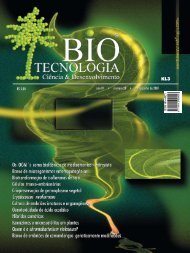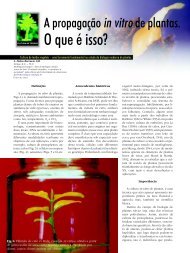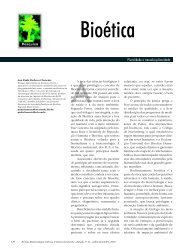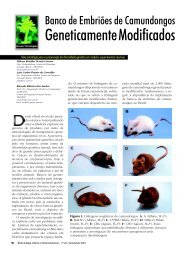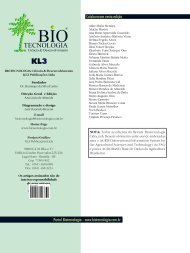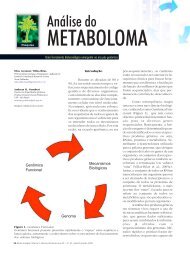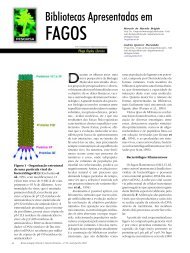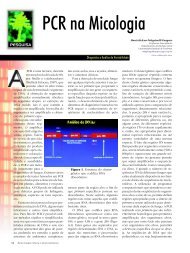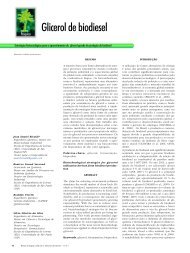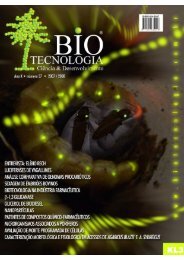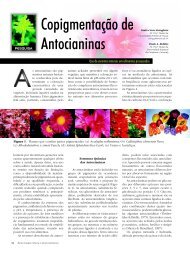Aprendendo com as agrobacterias - Biotecnologia
Aprendendo com as agrobacterias - Biotecnologia
Aprendendo com as agrobacterias - Biotecnologia
Create successful ePaper yourself
Turn your PDF publications into a flip-book with our unique Google optimized e-Paper software.
endogâmic<strong>as</strong>, (P 1<br />
x P 2<br />
), híbrido simples;<br />
de três linhagens endogâmic<strong>as</strong>,<br />
[(P 1<br />
x P 2<br />
) x P 3<br />
], híbrido triplo; ou de<br />
quatro linhagens endogâmic<strong>as</strong>, [(P 1<br />
x<br />
P 2<br />
) x (P 3<br />
x P 4<br />
)], híbrido duplo. Além d<strong>as</strong><br />
linhagens endogâmic<strong>as</strong>, podem-se utilizar<br />
variedades de polinização aberta,<br />
clones ou linh<strong>as</strong> pur<strong>as</strong> na obtenção dos<br />
híbridos.<br />
Clone<br />
O clone é constituído por um grupo<br />
de indivíduos que descendem, por<br />
propagação <strong>as</strong>sexuada, de um único<br />
genitor. Os clones são heterozigóticos<br />
e, em geral, homogêneos. Os indivíduos<br />
de um mesmo clone são geneticamente<br />
idênticos.<br />
N<strong>as</strong> espécies de propagação<br />
<strong>as</strong>sexuada, há uma correlação positiva<br />
entre grau de heterozigose e vigor.<br />
Por isso, <strong>as</strong> variedades clonais são em<br />
geral altamente heterozigótic<strong>as</strong>.<br />
Outros tipos de cultivares <strong>com</strong>o<br />
multilinh<strong>as</strong>, sintéticos, variedades de<br />
polinização aberta e outr<strong>as</strong> podem<br />
eventualmente ser utilizad<strong>as</strong> pelos<br />
agricultores.<br />
Conclusões<br />
Genes convencionais ou transgenes<br />
não possuem capacidade autônoma<br />
de reprodução ou de multiplicação por<br />
si só. Para a perpetuação de um gene<br />
ele precisa estar inserido em uma planta<br />
ou em uma de su<strong>as</strong> partes, que<br />
possua viabilidade, a exemplo d<strong>as</strong> sementes.<br />
Referênci<strong>as</strong> bibliográfic<strong>as</strong><br />
ADAMS, M.W., SHANK, D.B.<br />
The relationship of heterozigosity<br />
to homeost<strong>as</strong>is in maize hybrids.<br />
Genetics, 44:777-787.<br />
BOREM, A. 2003. Melhoramento<br />
de plant<strong>as</strong>. Viçosa Editora UFV.<br />
500p.<br />
BOREM, A. 1999. Melhoramento<br />
de especies cultivad<strong>as</strong>. Viçosa<br />
Editora UFV. 816p.<br />
BORLANG, N.E. 1959. The use<br />
of multilineal or <strong>com</strong>posite varieties<br />
to control airborne epidemic<br />
dise<strong>as</strong>es of self-pollinated crop<br />
plants. In: INT. WHEAT GENET.<br />
SYMP. UNIVERSITY OF<br />
MANITOBA, 1. Proceedings...<br />
Winnipeg, University of Manitoba.<br />
p. 12-26.<br />
BROWNING, J.A., FREY, K.J.<br />
1969. Multiline cultivars <strong>as</strong> a means<br />
of dise<strong>as</strong>e control. Annu. Rev.<br />
Phytopathol., 7:355-382.<br />
DICKERSON, G.E. 1963.<br />
Biological interpretations of the<br />
genetic parameters of populations<br />
pp. 95-107. In: HANSON, W.D.,<br />
ROBINSON, H.F. (Eds.). Statistical<br />
genetics and plant breeding. W<strong>as</strong>hington,<br />
D.C. (Pub. 982. NAS-<br />
NRC).<br />
EBERHART, S.A., RUSSEL, W.A.<br />
1969. Yield and stability for a 10-<br />
line diallel of single-cross and<br />
double-cross maize hybrids. Crop<br />
Sci., 9:357-361.<br />
FREY, K.J., CHANDHANA-<br />
MUTTA, P. 1975. Spontaneous<br />
mutations <strong>as</strong> a source of variation<br />
in diploid, tetraploid and hexaploid<br />
oats (Avena spp.) Egypt. J.<br />
Genet. Cyto., 4:238-249.<br />
HARLAN, H.V., MARTINI, M.L.,<br />
HARLAN, S. 1940. A study of<br />
methods in barley breeding. W<strong>as</strong>hington:<br />
USDA.<br />
HARLAN, J.R. 1971. Agricultural<br />
origins: Centers and noncenters.<br />
Science, 174:468-474.<br />
HARLAN, J.R., WET de, J.M.J.<br />
1971. Toward a rational cl<strong>as</strong>sification<br />
of cultivated plants. Taxon,<br />
20:509-517.<br />
INTERNATIONAL CODE OF<br />
NOMENCLATURE FOR CULTIVA-<br />
TED PLANTS. 1980. Reg. Veget.,<br />
4:7-32.<br />
KEMPTHORNE, O. 1957. An<br />
introduction to genetic statistics.<br />
New York: John Wiley Sons.<br />
NATIONAL ACADEMY OF SCI-<br />
ENCE, 1972. Genetic vulnerability<br />
of major crops. W<strong>as</strong>hington, D.C.<br />
PFEIFFER, T.W., SURYATI, D.,<br />
EGLI, D.B. 1991. Soybean plant<br />
introductions selected for seed<br />
filling period or yield: performance<br />
of parents. Crop Sci., 1:1418-1421.<br />
SCHNELL, F.W. 1975. Type of<br />
variety and average performance<br />
in hibrid maize Z. Pflanzenzucht,<br />
74:177-184.<br />
SCHOENER, C.S., FEHR, W.R.<br />
1979. Utilization of plant<br />
introductions in soybean<br />
populations. Crop Sci., 19:185-188.<br />
SHANDS, H.L., WIESNER, L.E.<br />
1991. Use of plant introductions in<br />
cultivar development: proceedings<br />
of a symposium. (CSSA publicação<br />
especial, 17).<br />
SPRAGUE, G.F., JENKINS, M.T.<br />
1943. A <strong>com</strong>parison of synthetic<br />
varieties, multiple crosses, and<br />
double crosses in corn. J. Am. Soc.<br />
Agron., 35:137-147.<br />
SPRAGUE, G.F. 1967. Plant<br />
breeding. Annu. Rev. Genet.,<br />
1:196-294.<br />
SUNESON, C.A. 1956.<br />
Evolutionary plant breeding. Agron.<br />
J., 48:188-190.<br />
VAVILOV, N.I. 1951. The origin,<br />
variation, immunity, and breeding<br />
of cultivated plants. Translated<br />
from Russian by K. Starr Chester.<br />
(Chronica Botanica, 1/6.).<br />
WEATHERSPOON, J.H. 1970.<br />
Comparative yield of single, threeway,<br />
and double-crosses of maize.<br />
Crop Sci., 10:157-159.<br />
WHEAT, J.G., FREY, K.J. 1961.<br />
Number of lines needed in oatvariety<br />
purification. Crop Sci.,<br />
53:39-41.<br />
ZEVEN, A.C. 1980. The spread<br />
of bread wheat over the old world<br />
since the neolithicum <strong>as</strong> indicated<br />
by its genotype for hybrid necrosis.<br />
J. Agric. Trad. Bota. Appl., 27:19-<br />
45.<br />
<strong>Biotecnologia</strong> Ciência & Desenvolvimento n.32 - janeiro/junho 2004 63



